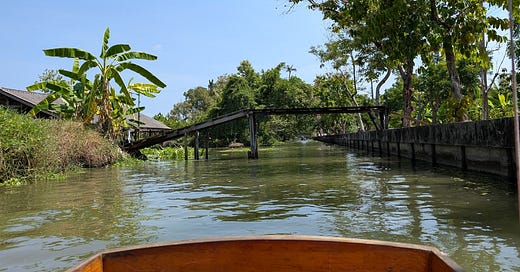Grab bag (Week 16/2025)
Strategic uncertainty; revelations and discoveries; video blahblah; coffee, smuggling, and subaks; Swiss tools and nonreversible work.
Hello friends,
I’m in Bangkok this week for a protocol design fiction workshop funded by the Ethereum Foundation’s protocols research programme. So I’ve been fully deployed all week, and new writing has gone on the back burner. That’s why this grab bag highlights two early essays from this newsletter which seem especially relevant now.
Writing
The usual business playbook struggles with the messy reality of uncertainty. This piece argues that our “best practice” systems often make us worse at handling it. Yet, this very inability creates opportunity for those who can deal with uncertainty (which is not the same as risk). Recognizing and managing the unknown becomes a strategic advantage.
👉 Read more here about strategic uncertainty.
Uncertainty is either involuntary (revealed to you) or voluntary (actively sought). Uncertainty of any kind is inherently difficult and costly. But choosing to engage with uncertainty voluntarily allows you to face it strategically: at a manageable scale, and at a better time when you're equipped to handle it.
👉 Read more here about revelations or discoveries of uncertainty.
Featured
In March, Keith Yap got in touch to suggest recording a long studio conversation. We did it in April and talked about the difference between uncertainty and risk, nonintuitively effective ways to organise for innovation, the virtues of discomfort, how to educate students to be more comfortable with being uncomfortable, and the inescapable smallness of Southeast Asian markets.
👉 The full video is available to watch here.
In Bangkok
Axiom: The more lightly specified in advance an event is, the more it will accumulate participants comfortable with amorphousness and uncertainty. Those often have diverse reading tastes.
Three pieces recommended to me by this week:
Martin Zaraska on searching for nonstandard coffee species (beyond robusta and arabica).
Alain Tarrius on the hard-to-see economy of Mediterranean smuggling.
J. Stephen Lansing on hard-to-see order in traditional Balinese sociotechnologies.
And two pieces the week’s discussions reminded me of:
Sigfried Giedion on how use transforms objects (even as objects transform uses).
David Pye on what workmanship is, and how it interacts with time and reversibility.
See you next week,
VT
And a noodle discursus
Last Saturday night, I convinced one of the workshop co-organisers to abandon industry and come with me on a kuay teow kua gai crawl.
The dish is usually listed as something like fried wide rice noodles with chicken and egg. That description does not communicate the degree of technical precision needed to cook it well, nor the heights of flavour and texture that can be achieved by someone who cooks the dish every day for years.
In the short alley we went to, there were maybe 6 independent stands. Each sold mainly kua gai. The best ones were from the stalls cooking in small steel woks over charcoal fires. These fires were running so hot that the bases of the woks had been burned back to clean metal. From my fragmentary observation, the method is: Begin by cooking the fresh rice noodles (they’re generally wider, thinner, and more glutinous than the regular kuayteow I’m used to) loosely with chopped preserved turnip in an uncrowded, well-oiled, and very hot pan. The noodles scorch lightly, then raw marinated chicken is added to cook, then lightly beaten egg is added. The whole mass is allowed to cook undisturbed for a brief period, and flipped a few times.
What results from high-level execution is an object lesson in contrast: Chewy and lightly crisp noodles with light wok hei, barely cooked chicken that still has scorched edges, and egg variably custardy and browned. The savoriness comes from the marinated chicken and preserved turnip.
A good kuay teow kua gai is a rare dish to be sought out.




